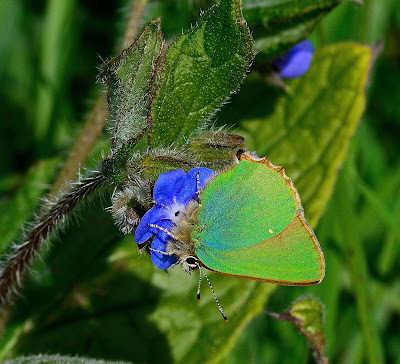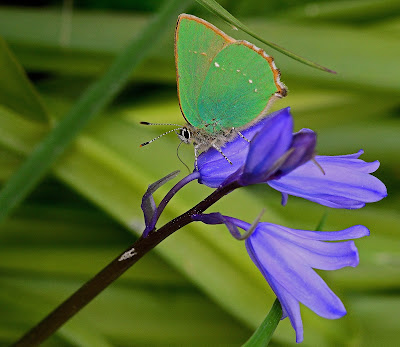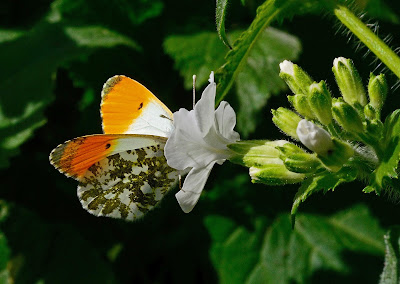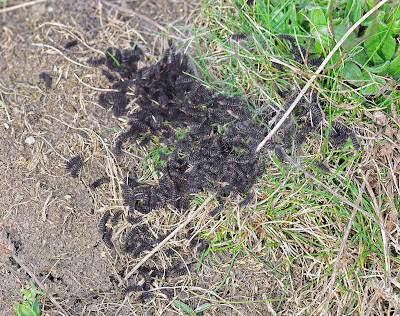The first Orange Tip,a male, flew around my garden today.Most years I do not see this species in my garden until May, so much earlier than expected.Activity of this species has been evident since the first week in April when at Ventnor I came across a female taking great interest in the Honesty plants.She was soon joined by a male who fluttered feverishly around her.Her response,in this instance,was a rejection of his advances in typical Orange Tip fashion.Females who have already mated and want to shoo away a male will flatten their wings and raise their abdomen.This is followed by an opening of the genital valve to release anti-aphrodisiac hormones to discourage the male.
Monday 17 April 2017
Sunday 16 April 2017
Cooler Temperatures Slow Down the Spring Butterflies.
Although the weather has been dry and mainly sunny since the unseasonably warm temperatures of last weekend,a nagging cold wind has seemed to postpone the emergence of new spring butterflies here along the coast.This is so at Whiteways Quarry where no new species have been seen on the wing.However today the two Green Hairstreaks at the site were enjoying the Bluebells and the elusive Grizzled Skipper still puts in an occasional appearance.
Wednesday 12 April 2017
First Small Heath.
The weather today had cooled due to a brisk wind and butterflies already recorded at Whiteways Quarry were not to be seen.However a new species did make an appearance here,a single Small Heath,the first of 2017.This is the earliest date for a sighting of this species since I began recording in 2010.
Tuesday 11 April 2017
First Grizzled Skipper.
As anticipated the first Grizzled Skipper made an appearance at Whiteways Quarry today and the Green Hairstreaks seem to have doubled their number to two.With the mainly dry weather forecast to continue for the rest of the week we can look forward to six further species emerging at this site.
Monday 10 April 2017
First Green Hairstreak.
With the very warm temperatures of the last few days I would have expected the first new spring butterflies to appear sooner at Whiteways Quarry(Afton Down Chalkpit).However it was not until today that a Green Hairstreak was seen and I expect that it will now be closely followed by this unique sites other gems.

.
Sunday 9 April 2017
Getting Ready.
The Glanville Fritillary caterpillars will soon be ready to disperse and pupate.Their flying season could be just three weeks away.Many of the larva that I saw yesterday are in the sixth instar and these larger larvae can be seen merrily munching on plantain leaves.However some caterpillars have not reached that final stage and are still seeking the safety of their webs.Some webs also show signs of their development with discarded moult skins.
 |
| Web with discarded larval skins |
Thursday 6 April 2017
Speckled Woods & Peacocks On Show.
It was a lovely sunny spring afternoon although the butterflies did not seem to be much in evidence during my walk in Walters Copse at Newtown.Still,at least six Speckled Wood had claimed several sun dappled spots in the wood and I had a glimpse of a Small/Green-veined White as it flew along a ride as I entered the Copse.
The Peacock seems to be very abundant this year and they are a regular sight here.Male Peacock butterflies set up their territories on the ground often in a sunny location at the end of a woodland ride and I came across one such spot in the copse today.The male(pictured below on the left of the photo) had attracted a female and he was gently opening and closing his wings in a courtship ritual while edging as close as possible to her.An example of this behaviour can been seen HERE The display abruptly ended when she flew off into the high branches of a nearby tree swiftly followed by the male.In contrast to the prevalence of the Peacock,the Red Admiral is a rare sight at the moment so I was glad to have a single sighting.Another all too brief sighting was a Holly Blue flying busily along a sunny track.

The Peacock seems to be very abundant this year and they are a regular sight here.Male Peacock butterflies set up their territories on the ground often in a sunny location at the end of a woodland ride and I came across one such spot in the copse today.The male(pictured below on the left of the photo) had attracted a female and he was gently opening and closing his wings in a courtship ritual while edging as close as possible to her.An example of this behaviour can been seen HERE The display abruptly ended when she flew off into the high branches of a nearby tree swiftly followed by the male.In contrast to the prevalence of the Peacock,the Red Admiral is a rare sight at the moment so I was glad to have a single sighting.Another all too brief sighting was a Holly Blue flying busily along a sunny track.

Monday 3 April 2017
New Spring Butterflies.
Spring has now arrived and several newly emerged species are to be seen on the wing.It is always a treat to see the first Orange Tip and at Wheelers Bay today a male was busily feeding on the flowers of the many Honesty plants that grow in any sheltered sunny spot.Another new species here was a male Holly Blue which occasionally stopped its brakeneck flight to nectar on any blooms.
Back at home a female Large White visited my garden to feed on the abundant flowers of our Berberis.This shrub is always a magnet for the bumblebees and also it seems, for this hungry White.


Saturday 25 March 2017
On The Up.
A further visit to Walters Copse today saw an increase in butterfly sightings compared with a fortnight ago despite a brisk easterly wind.However in some spots of the copse it was sheltered away from the cool breeze and became relatively warm in the sunshine.Best of all was the number of Brimstone, reaching double figures as the males patrolled the rides on the lookout for females.Occasionally they took time out to visit the many primrose plants that now bloom throughout the copse.Unfortunately I did not encounter any new spring emergents, as the only other butterflies on the wing were Peacock and Commas.
Sunday 12 March 2017
Warm Temperatures Bring On the Butterflies.
We enjoyed above average temperatures yesterday on the Island and it was most likely the warmest day of the year so far.Therefore,I was not surprised to see my first butterfly of 2017 sunning itself on the ground in my garden.No doubt this Peacock had just come out of hibernation and was after some nutrition.It soon flew onto a daffodil where it began to nectar.
After lunch I made a short car ride along the coast and visited one of the numerous Chines that are found here to see the state of Glanville Fritillary caterpillar webs that dot the sides of the coastal cliffs.With the sunshine warming up these grassy knolls caterpillars were evident although at this time they are small,only 6mm or so in length.By late April they will have grown considerably and will begin to disperse from their communal webs to find place to pupate.
.
After lunch I made a short car ride along the coast and visited one of the numerous Chines that are found here to see the state of Glanville Fritillary caterpillar webs that dot the sides of the coastal cliffs.With the sunshine warming up these grassy knolls caterpillars were evident although at this time they are small,only 6mm or so in length.By late April they will have grown considerably and will begin to disperse from their communal webs to find place to pupate.
.
Subscribe to:
Posts (Atom)

























